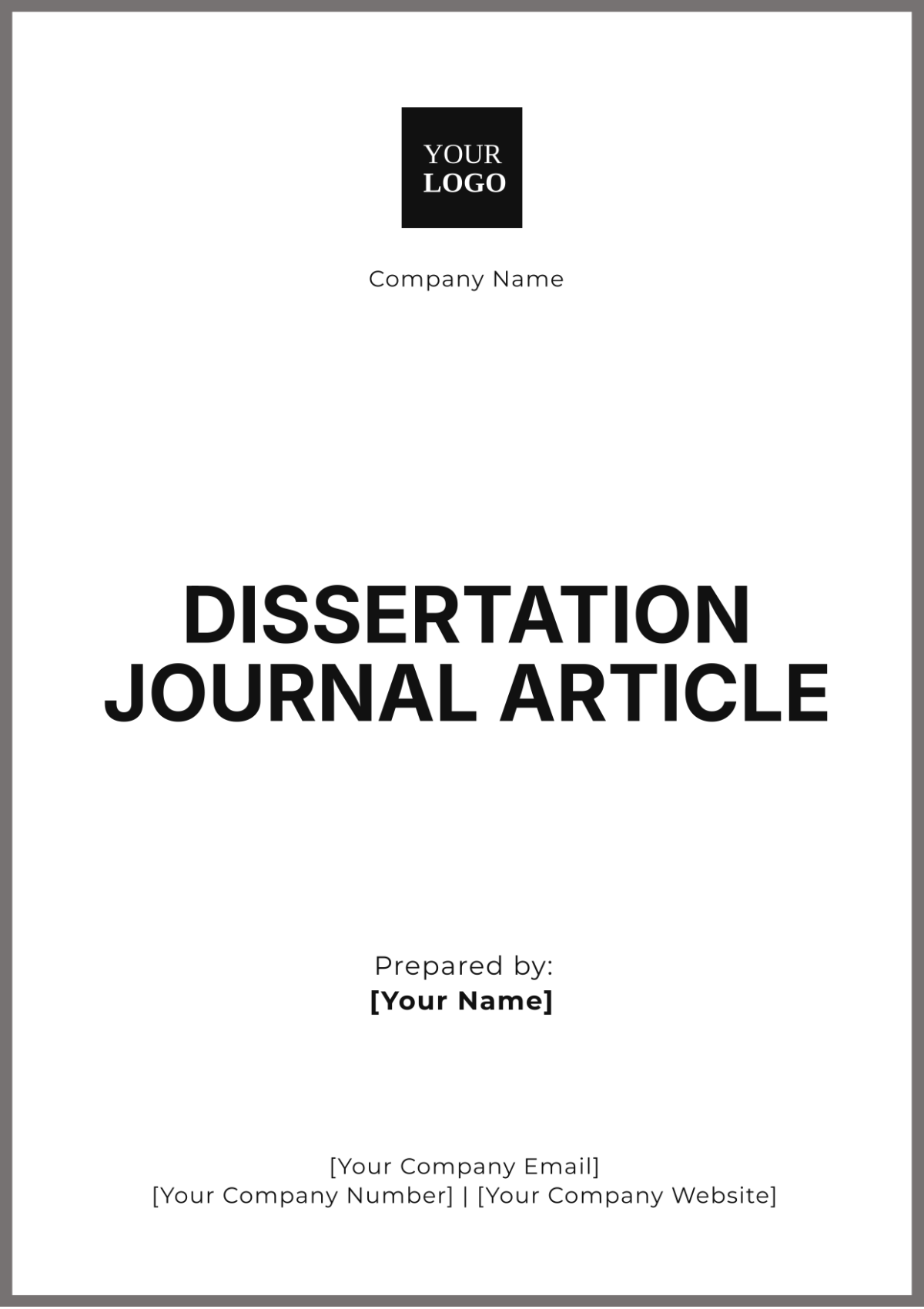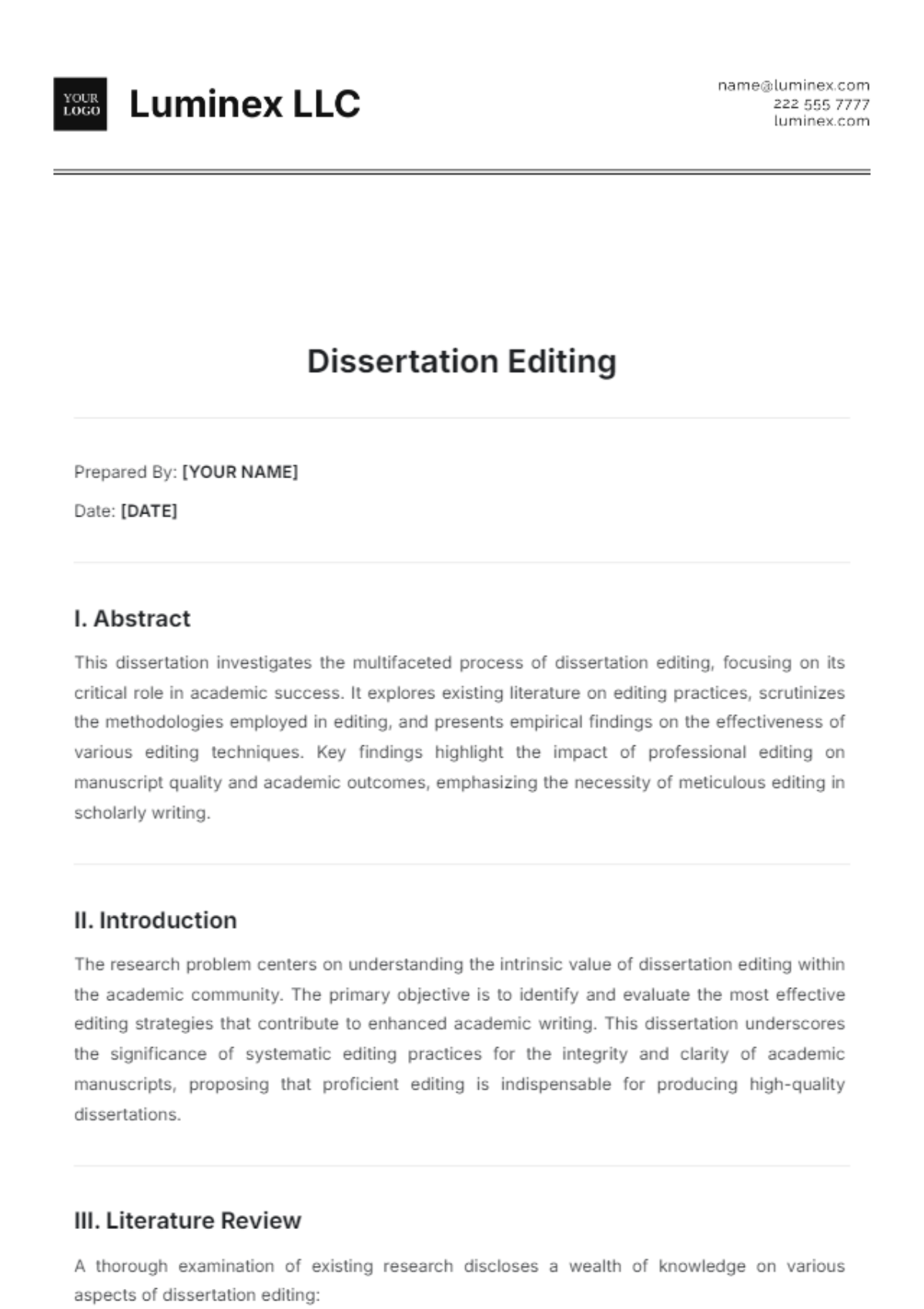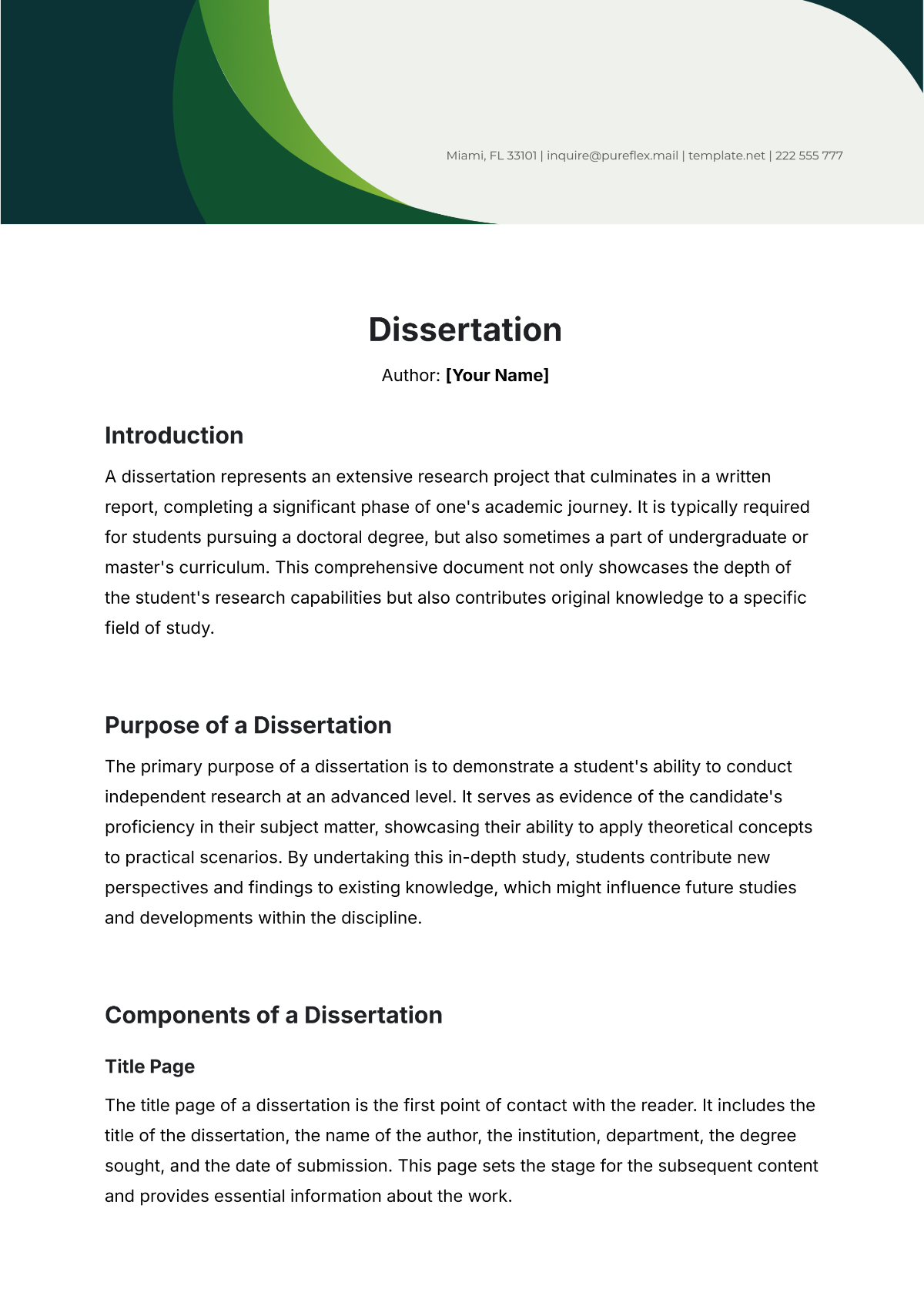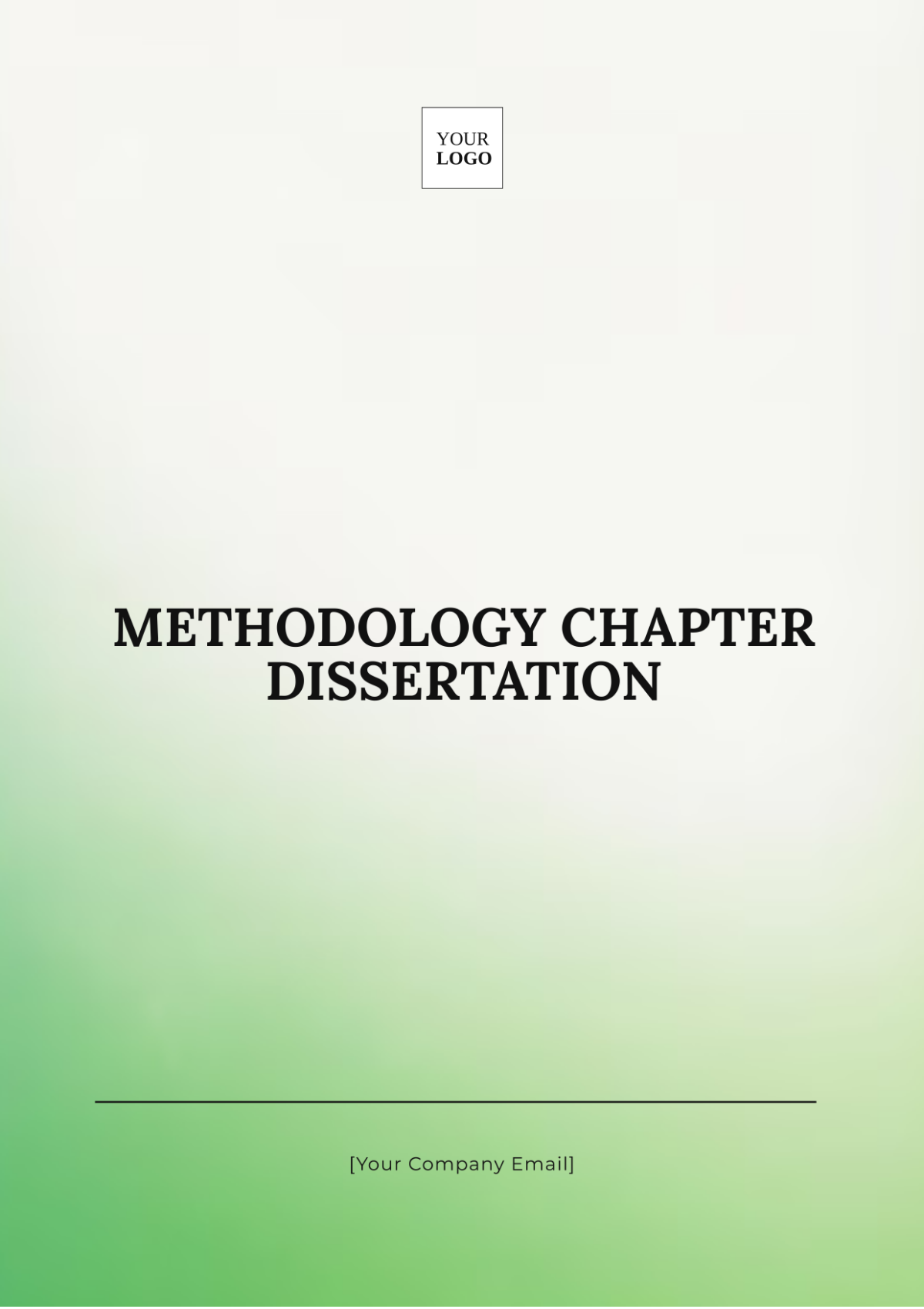Results Chapter Dissertation
Prepared by: [Your Name]
Date: [Date]
I. Introduction
The Results Chapter presents a detailed account of the findings from the research conducted. This chapter is structured to provide a clear and comprehensive summary of the data collected, whether through statistical analysis or qualitative methods. The primary focus is on reporting the outcomes without delving into their significance or implications, which will be covered in subsequent chapters.
This chapter is divided into several sections including Data Presentation, Descriptive Statistics, Inferential Statistics, Qualitative Findings, and Subgroup Analysis. Each section is organized to ensure clarity and depth in presenting the research results.
II. Data Presentation
The data collected for this research is presented systematically in this section. Both quantitative and qualitative data are included, and where applicable, tables and figures are used to offer a visual representation of the findings.
II.I Quantitative Data
The quantitative data comprises numerical values obtained from surveys and experiments carried out during the study. Below is a tabular representation of the key metrics collected.
Variable | Mean | Median | Standard Deviation | N |
|---|---|---|---|---|
Variable 1 | 23.4 | 22.5 | 4.6 | 150 |
Variable 2 | 34.1 | 33.8 | 5.2 | 150 |
Variable 3 | 12.8 | 12.5 | 3.3 | 150 |
Variable 4 | 56.7 | 57.0 | 6.7 | 150 |
II.II Qualitative Data
The qualitative data was gathered through interviews and open-ended survey questions. The responses were coded and categorized into themes. Notable excerpts from participant responses include:
"The program helped improve my skills significantly."
"I found the sessions to be engaging and informative."
"More practical examples could enhance understanding."
"The support provided was invaluable for my personal growth."
III. Descriptive Statistics
Descriptive statistics provide a summary of the central tendency, dispersion, and shape of the dataset’s distribution. This section outlines key descriptive statistics for the primary variables.
III.I Measures of Central Tendency
The measures of central tendency for the key variables are as follows:
Measure | Variable | Value |
|---|---|---|
Mean Age of Participants | Age | 29.8 years |
Median Income | Income | $50,000 |
Mode for Education Level | Education Level | Bachelor's Degree |
Mean Satisfaction Score | Satisfaction Score | 8.2/10 |
III.II Measures of Dispersion
The measures of dispersion provide insights into the spread of the data:
Measure | Value |
|---|---|
Range of Ages | 22 - 45 years |
Standard Deviation of Income | $12,000 |
Variance in Satisfaction Scores | 2.8 |
Range of Satisfaction Scores | 5 - 10 |
IV. Inferential Statistics
Inferential statistics are used to draw conclusions from the sample data by making generalizations about the population. This section provides the results from various inferential statistical tests conducted.
IV.I Regression Analysis
A multiple regression analysis was performed to examine the influence of independent variables on the dependent variable. The regression equation was found to be significant at p < 0.05
Variable | Unstandardized Coefficient (B) | Standard Error | t-value | p-value |
|---|---|---|---|---|
Independent Variable 1 | 0.45 | 0.10 | 4.50 | 0.000 |
Independent Variable 2 | 0.30 | 0.12 | 2.50 | 0.014 |
Independent Variable 3 | 0.25 | 0.11 | 2.27 | 0.024 |
IV.II ANOVA Test
An ANOVA test was conducted to compare the means of different groups. The test results show significant differences among the groups (F(3, 146) = 5.67, p = 0.001). Post-hoc analyses revealed that Group A significantly differed from Groups B and C.
V. Qualitative Findings
The qualitative findings are derived from thematic analysis of the interview transcripts and open-ended survey responses. This section provides a detailed account of the identified themes.
Theme 1: Improvement in Skills
Many participants reported noticeable improvement in their skills post-intervention. Sample excerpts include:
"I have become more proficient in handling tasks."
"The training sessions were crucial for my development."
"I feel more confident in my abilities."
Theme 2: Challenges Faced
Despite the positive outcomes, participants also highlighted several challenges:
"Lack of sufficient resources was a major hurdle."
"Time constraints impacted my ability to fully engage."
"The program could benefit from additional support materials.
VI. Subgroup Analysis
Subgroup analysis was conducted to explore variations in results across different demographic groups such as age, gender, and education level. This section provides a summary of these findings.
A. Age Groups
The results indicated significant differences in outcomes across age groups. Younger participants (aged 22-30) showed greater improvement in skills compared to older participants (aged 31-45). The younger cohort had an average skill improvement score of 85%, while the older cohort had a score of 72%.
B. Gender
No significant differences were observed between male and female participants in terms of the measured outcomes. Both genders reported similar levels of satisfaction and skill improvement.
C. Education Level
Participants with a higher education level (Master's Degree) reported greater satisfaction with the program compared to those with a lower education level (Bachelor's Degree). The satisfaction score for those with a Master’s Degree averaged 9.0, while those with a Bachelor’s Degree averaged 7.5.
VII. Summary
The Results Chapter has provided a comprehensive summary of the findings from the quantitative and qualitative data collected. The data presentation section outlined the key metrics and themes identified. Descriptive statistics offered insights into the central tendencies and dispersion of the dataset, while inferential statistics allowed for generalizations about the population. Qualitative findings highlighted participant experiences and challenges, and subgroup analysis shed light on variations across different demographic groups.
The next chapter will interpret these findings in the context of the existing literature and theoretical framework, providing a deeper understanding of their significance and implications.

















































